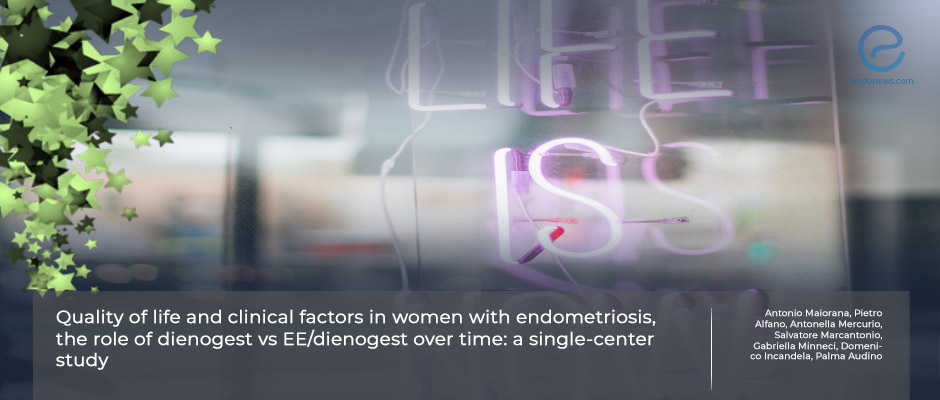The effect of dienogest vs ethynyl estradiol/dienogest on quality of life in women with endometriosis
Jun 1, 2023
Endometriosis is a chronic inflammatory disease with physical, social and psychological aspects resulting in diminished quality of women’s life.
Key Points
Highlights:
- The treatment of endometriosis with dienogest and ethynyl estradiol/dienogest improves the physical component of quality of life, general pain perception, health-related quality of life, and symptoms such as dysmenorrhea.
Importance:
- A multidisciplinary approach and education are important to decrease the negative effect of endometriosis on the quality of life.
What’s done here?
- This observational single-center study was conducted to clarify the relationship between psychological variables, pain, and Duration of Untreated Endometriosis.
- The effect of dienogest 2 mg/daily (DNG) and dienogest/ethinylestradiol 0.03 mg/daily (EE/DNG) on symptoms, health-related quality of life, pain, and sexual satisfaction were also evaluated.
- Medical therapy with DNG and EE/DNG was recommended to the patients depending on personalized clinical indications.
- All participants were assessed for clinical assessment and psychological evaluation at the beginning of treatment and at 18 months.
- Health-related Quality of Life Short Form Survey, “Endometriosis health profile-30” and “Index of sexual satisfaction” were used for evaluation.
- Endometriosis-associated pain, chronic pelvic pain, dysmenorrhea, dyspareunia, and dyschezia were scored using “Visual analog score (VAS)”.
Key results:
- A total of 64 endometriosis patients were recruited in this observational study: 36 in DNG and 28 in EE/DNG groups.
- Women in EE/DNG group were younger at the time of diagnosis and at the first symptoms.
- Survey results, dysmenorrhea, dyschezia, and dyspareunia did not differ significantly between the groups.
- There was a correlation between a longer duration of untreated endometriosis and worse health-related quality of life and physical quality of life.
- Both DNG and EE/DNG treatment provide a reduction in dysmenorrhea, general pain level, and an improvement in emotional well-being and relationship with the medical profession.
- However, DNG resulted in a greater effect than EE/DNG on dyspareunia reduction over time.
Strengths and Limitations:
- Strict inclusion criteria and the use of different questionnaires are the main strengths.
- The small sample size and no possibility to understand all the bio-psychosocial aspects involved in women’s well-being and pain experience are the limitations.
Lay Summary
Women with endometriosis suffer from dysmenorrhea, dyspareunia, and chronic pelvic pain that diminishes the quality of their life. Both physical and mental components of quality of life have been affected by endometriosis-associated symptoms. There are several medical and surgical treatment options to manage these women. However, none may provide a permanent solution to increase the quality of life.
Maiorana et al. from Italy published an observational single-center study titled “Quality of life and clinical factors in women with endometriosis, the role of dienogest vs EE/dienogest over time: a single‑center study” in the journal Archives of Gynecology and Obstetrics. The authors aimed to assess the relationship between psychological variables, pain, and duration of untreated endometriosis.
The effect of dienogest (DNG) and dienogest/ethinylestradiol (EE/DNG) on symptoms, quality of life, health-related quality of life, pain, and sexual satisfaction were also evaluated in women with endometriosis over time. Questionnaires such as SF-36, EHP-30, ISS, VAS were used to investigate clinical assessment and psychological evaluation of all participants at the beginning of treatment and at 18 months.
Women in EE/DNG group were younger at the time of diagnosis and at the first symptoms. SF-36, EHP-30, ISS, VAS, dysmenorrhea, dyschezia, and dyspareunia did not significantly differ between the groups. Both DNG and EE/DNG treatment provided a reduction in dysmenorrhea, in general pain level, an improvement in emotional well-being, and a relationship with the medical profession while DNG resulted in a greater effect than EE/DNG on dyspareunia reduction over time.
“The need for a multidisciplinary approach and clinician education to decrease the effect of endometriosis on women’s QoL and to reduce the duration of untreated endometriosis.” the authors added.
Research Source: https://pubmed.ncbi.nlm.nih.gov/36738318/
endometriosis dyspareunia health-related quality of life sexual satisfaction pain SF-36 EHP-30 ISS VAS

